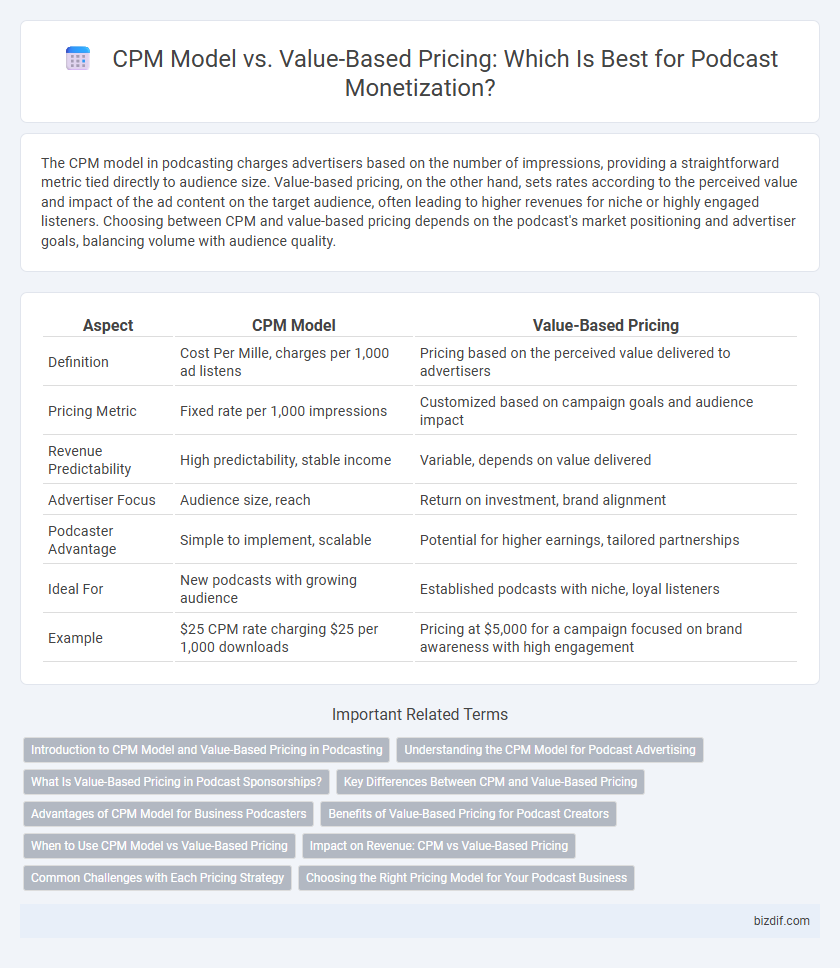The CPM model in podcasting charges advertisers based on the number of impressions, providing a straightforward metric tied directly to audience size. Value-based pricing, on the other hand, sets rates according to the perceived value and impact of the ad content on the target audience, often leading to higher revenues for niche or highly engaged listeners. Choosing between CPM and value-based pricing depends on the podcast's market positioning and advertiser goals, balancing volume with audience quality.
Table of Comparison
| Aspect | CPM Model | Value-Based Pricing |
|---|---|---|
| Definition | Cost Per Mille, charges per 1,000 ad listens | Pricing based on the perceived value delivered to advertisers |
| Pricing Metric | Fixed rate per 1,000 impressions | Customized based on campaign goals and audience impact |
| Revenue Predictability | High predictability, stable income | Variable, depends on value delivered |
| Advertiser Focus | Audience size, reach | Return on investment, brand alignment |
| Podcaster Advantage | Simple to implement, scalable | Potential for higher earnings, tailored partnerships |
| Ideal For | New podcasts with growing audience | Established podcasts with niche, loyal listeners |
| Example | $25 CPM rate charging $25 per 1,000 downloads | Pricing at $5,000 for a campaign focused on brand awareness with high engagement |
Introduction to CPM Model and Value-Based Pricing in Podcasting
The CPM model in podcasting charges advertisers based on the cost per thousand listens, providing a straightforward metric tied to audience size and reach. Value-based pricing sets rates according to the perceived value and impact of the podcast's content on the target audience, often reflecting engagement and niche market influence. Understanding these pricing models helps podcasters balance revenue generation with the unique qualities of their content and listener base.
Understanding the CPM Model for Podcast Advertising
The CPM (Cost Per Mille) model in podcast advertising charges advertisers based on every thousand listeners reached, providing a straightforward metric for campaign budgeting and performance measurement. This pricing strategy allows podcasters to monetize content effectively by aligning ad costs with audience size, though it may not fully capture the perceived value or listener engagement. Understanding CPM is essential for balancing ad revenue with audience experience and for comparing it against value-based pricing, which considers listener loyalty and ad impact beyond mere impressions.
What Is Value-Based Pricing in Podcast Sponsorships?
Value-based pricing in podcast sponsorships sets ad rates according to the perceived value delivered to the advertiser, often linked to specific audience demographics, engagement levels, and campaign objectives. Unlike the CPM model, which charges a fixed rate per thousand impressions, value-based pricing aligns costs with the actual business outcomes or brand impact generated by the sponsorship. This approach incentivizes podcasters to deliver targeted, high-quality content that maximizes advertiser ROI and enhances partnership longevity.
Key Differences Between CPM and Value-Based Pricing
CPM (Cost Per Mille) model charges advertisers based on every thousand ad impressions, providing a clear, volume-driven pricing metric commonly used in podcast advertising. Value-Based Pricing sets rates according to the perceived value of the ad placement and audience engagement, often resulting in higher revenue when targeting niche or premium listeners. Key differences include CPM's reliance on standardized metrics versus Value-Based Pricing's focus on audience quality, campaign goals, and brand alignment.
Advantages of CPM Model for Business Podcasters
The CPM (Cost Per Mille) model offers business podcasters predictable revenue streams by charging advertisers a fixed rate per thousand impressions, simplifying budgeting and forecasting. This pricing strategy attracts a broad range of advertisers due to its transparency and scalability, enabling podcasters to monetize large audiences efficiently. CPM also facilitates easier comparison across campaigns, helping podcasters optimize ad placements and maximize earnings.
Benefits of Value-Based Pricing for Podcast Creators
Value-Based Pricing empowers podcast creators to maximize revenue by aligning ad costs with the actual value their audience delivers to advertisers, rather than relying on standard CPM rates. This approach encourages premium pricing for niche or highly engaged audiences, resulting in better monetization opportunities and stronger partnerships. Podcast creators benefit from increased flexibility and profitability, fostering sustainable growth and enhanced content quality.
When to Use CPM Model vs Value-Based Pricing
CPM model suits podcast advertisers focused on predictable costs and broad reach, especially in campaigns targeting mass audiences or brand awareness. Value-based pricing works best for niche podcasts with highly engaged listeners, where ad placements deliver specialized value and measurable impact on conversions. Choosing between CPM and value-based pricing depends on campaign goals, audience specificity, and the advertiser's emphasis on volume versus engagement quality.
Impact on Revenue: CPM vs Value-Based Pricing
CPM model generates revenue based on the number of ad impressions, providing predictable income but often undervaluing niche or highly engaged audiences. Value-based pricing maximizes revenue by aligning charges with the perceived value and outcomes delivered to advertisers, especially effective for podcasts with loyal listeners and targeted content. This approach can significantly increase revenue potential by capturing the true market worth of the audience's engagement and advertiser ROI.
Common Challenges with Each Pricing Strategy
The CPM model often faces challenges in accurately reflecting content quality and audience engagement, leading to potential undervaluation of niche podcasts. Value-based pricing may struggle with subjective assessments of a podcast's worth, complicating advertiser negotiations and revenue consistency. Both strategies require careful calibration to balance advertiser goals and podcast monetization sustainability.
Choosing the Right Pricing Model for Your Podcast Business
CPM model charges advertisers based on every thousand ad impressions, offering predictable revenue for podcasts with large audiences, while value-based pricing sets rates according to the perceived value and engagement level of the podcast's content to advertisers. Selecting the right pricing model depends on your podcast's niche, audience size, and advertiser relationships, where CPM suits high-traffic shows and value-based pricing benefits podcasts with specialized, highly engaged listeners. Evaluating metrics like listener demographics, ad completion rates, and ROI helps optimize revenue by aligning pricing strategy with the unique strengths of your podcast business.
CPM Model vs Value-Based Pricing Infographic

 bizdif.com
bizdif.com